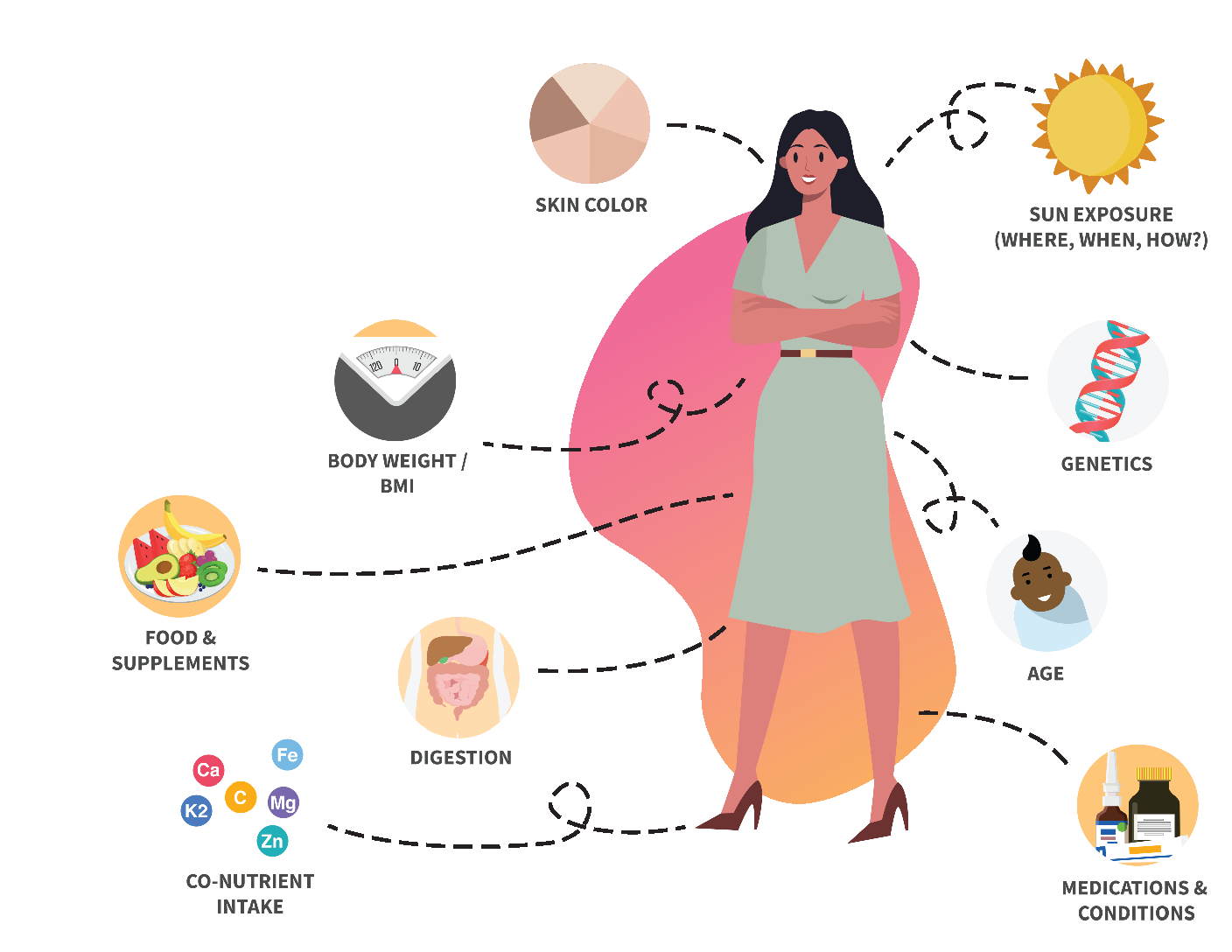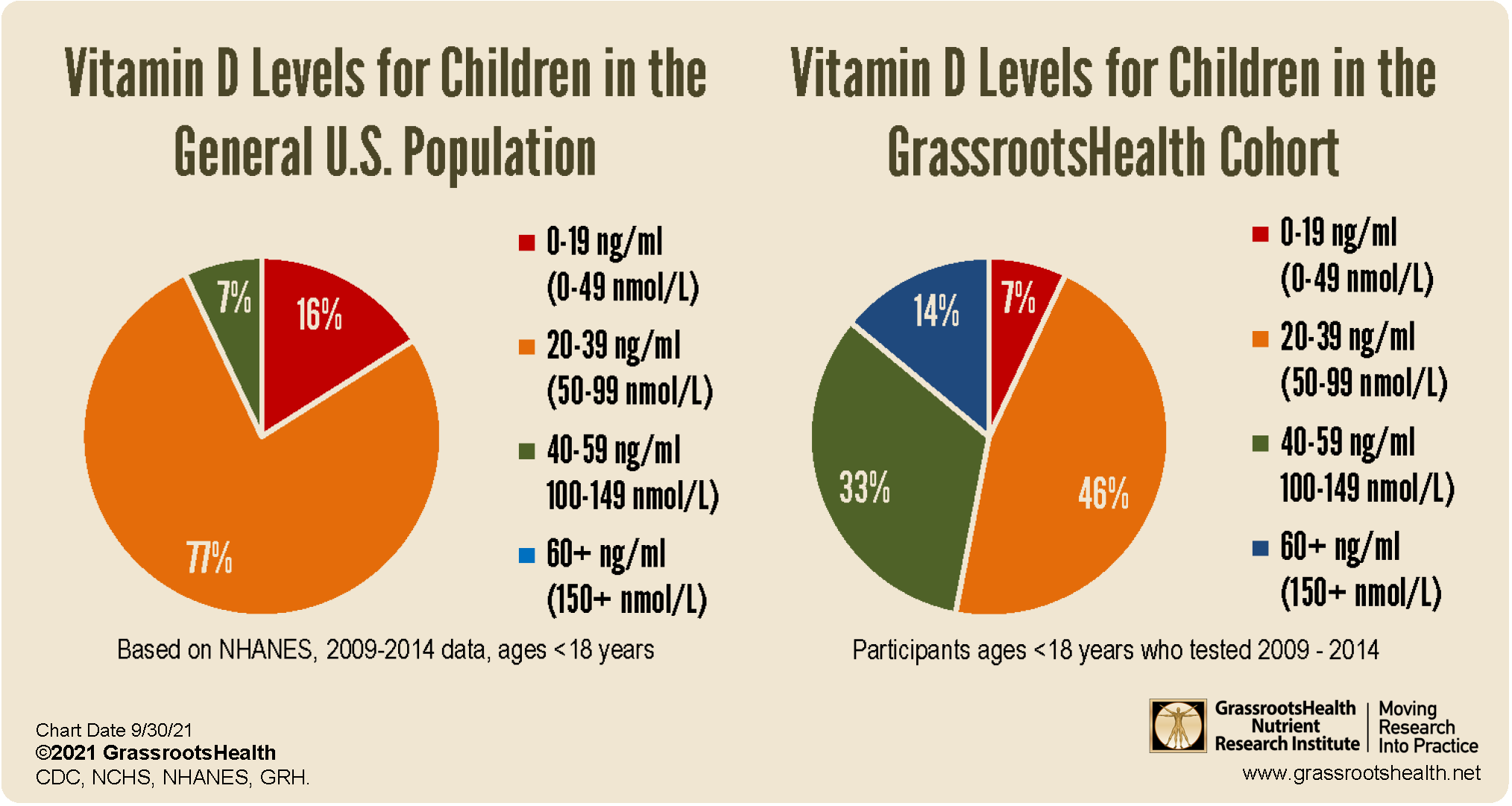Enroll children up to 18 today in the new Children of the World Project
Over 90% of children in the United States have vitamin D levels below the recommended 40 ng/ml – how can you help ensure your child is getting enough?
Key Points
- 93% of children in the general US population have vitamin D levels below 40 ng/ml (100 nmol/L), 16% of whom are below 20 ng/ml (50 nmol/L)
- Vitamin D levels tend to drop among children and teens as they age, likely due to the need for increased intake as they grow bigger. A general requirement for vitamin D intake from all sources is around 35 IU/pound (75 IU/kg) per day, on average.
- Not testing children’s levels as they age and grow can easily lead to vitamin D levels below what is recommended
- Studies show children can also benefit from having enough vitamin D to help decrease the risk of severe COVID-19
 Vitamin D is essential for everyone, but especially for growing children.
Vitamin D is essential for everyone, but especially for growing children.
Unfortunately, many children are not getting enough vitamin D, and the problem seems to worsen as they age.
According to 2009-2014 data from the National Health and Nutrition Examination Survey (NHANES) on children under the age of 18 in the United States, 93% had vitamin D levels below 40 ng/ml (100 nmol/L), with 16% of them below 20 ng/ml (50 nmol/L). That data is charted below next to data on children in the GrassrootsHealth cohort, among whom over 50% are still below the recommended 40 ng/ml, regardless of the fact that the parents testing their children through the project are educated enough about vitamin D to be measuring levels on their own.
 Children Grow – So Does Their Requirement for Vitamin D!
Children Grow – So Does Their Requirement for Vitamin D!
In a past analysis of vitamin D intake and levels among children in the GrassrootsHealth cohort, we discovered that as the age of the children increased, the percent of children with levels at or above 40 ng/ml decreased, from about two-thirds for those 0-4 years to about one-third for those 13-17 years. We also found that, while vitamin D intake should increase as body weight increases, intake remained the same or decreased as age increased, which is likely the main cause of the decreasing vitamin D levels with age.
How Can You Help Your Child Get the Amount of Vitamin D They Need?
Testing is the first step – based on their current blood level an appropriate dose of vitamin D can then be determined. Re-testing is necessary to ensure the target blood level has been reached.
Enroll children up to 18 today in the new Children of the World Project
Being a GrassrootsHealth Participant: Here’s How it All Works
 Step 1
Step 1
Order your home vitamin D test kit
(Include other nutrients or levels of your choice).
 Step 2
Step 2
Complete the questionnaire about your child’s health and habits, including supplement intake and sun exposure. This helps identify why a vitamin D level may or may not be as expected, and it contributes to our research as well!
 Step 3
Step 3
Get your child’s vitamin D result – it will be posted to your child’s online account.
GrassrootsHealth scientists recommend a vitamin D level of 40-60 ng/ml (100-150 nmol/L) Is your child’s level where you want it to be? If so – GREAT! Keep up the good work and continue participating in the project to provide more data on what it means for children to have a healthy vitamin D level.
If your child’s vitamin D level is not in your target range, follow the next steps:
 Step 4
Step 4
Use the D*calculator to determine an adjusted vitamin D supplement amount and educate yourself on other factors that affect vitamin D levels.
 Step 5
Step 5
Track their changes and re-test in 3-6 months
(or sooner if trying a loading dose).
 Step 6
Step 6
How did your changes affect your child’s vitamin D level? Did you reach your goal? Determine if additional adjustments are needed… repeat again if necessary.
Why is Testing SO Important?
Everyone responds differently to vitamin D… For the same dose taken, individual vitamin D level response can vary by a factor of six or more. In other words, what might be enough vitamin D for one person may not be enough for another. On top of all that, children are constantly growing, and as they grow, so does the amount of vitamin D their body needs.

What is Vitamin D Needed for in the Body?
Vitamin D is needed by virtually every cell in the body, and is essential for hundreds of processes each and every day. It acts as a protector and regulator of all cell types, tissues, and organs, and is able to enhance the functioning of each system of the body to help keep us healthy.

Vitamin D deficiency has been linked to:
Brain
Depression & Anxiety Schizophrenia, Alzheimer’s Disease, ADHD & Autism
Circulatory
High Blood Pressure, Peripheral Artery Disease, Coronary Heart Disease, Atrial Fibrillation
Respiratory
Colds & Flu, Pneumonia & Acute Respiratory Distress Syndrome (ARDS), Asthma, Tuberculosis
Muscle
Neuromuscular Pain, Weakness, Injury
Bone
Rickets, Osteoporosis Fracture
Auto-Immune Diabetes
Chrohn’s Disease, Cancer, Multiple Sclerosis, Psoriasis
Reproductive
Infertility, Preterm Birth & Prenatal Complications
And MORE!

 Click to Enlarge & Print
Click to Enlarge & Print Children Grow – So Does Their Requirement for Vitamin D!
Children Grow – So Does Their Requirement for Vitamin D!